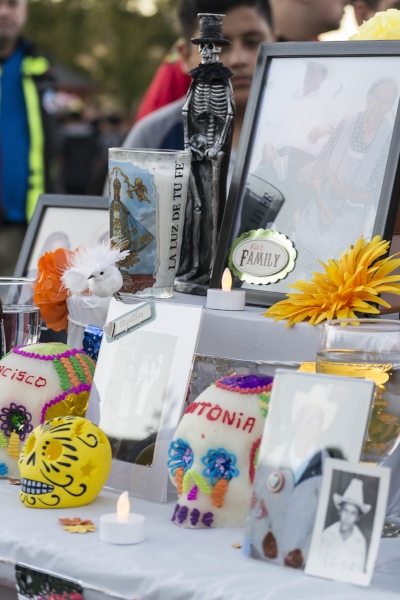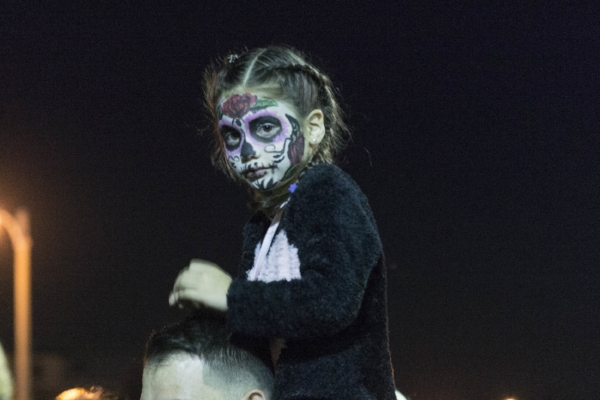
Día de Los Muertos
Día de los Muertos or Day of the Dead is a celebration in Mexico where it honors the memory of those who have passed away and is a celebration of life and death. Día de los Muertos is derived from an Aztec tradition where the festivities were done in honor of the godess Mictecacihuatl, Queen of Mictlan, the underworld. The festival was held annually in the beginning of August during the time the spirits of the deceased were allowed to return home from Mictlan, where they resided, to visit their loved ones. As time changed, the Aztec tradition shifted to incorporate the Catholic religion and to coincide with All Saints Day.
The midnight of October 31st, it is believed that the gates to the spirit world would open and let the souls of the deceased through, specifically the souls of children come through on this day and el Día de los Muertos celebration for the children who have passed is on November 1st. The souls of adults are then allowed to return the midnight on November 1st and are celebrated on November 2nd.
The tradition of el Día de los Muertos consists of ofrendas or altars that are made for the loved ones who have passed. The ofrendas are decorated with pictures and the deceased's favorite items and favorite foods along with sugar skulls with their name on the forhead to represent the deceased. The altars are also adorned with Wild Marigolds called cempasuchil and candles that are supposed to guide the souls of the loved ones back to the altar, along with sprinkled salt to keep away evil spirits so the deaceased can enjoy their food and time with their family. Ofrendas also incorporate the use of the four elements, fire, wind, water and earth which are also the elements the Aztecs believed the spirits of deceased needed to live happy in the afterlife.

A couple dressed together at el Día de los Muertos event at the National Musuem of Mexican Art in Pilsen on November 1st, 2015.

Día de Los Muertos, or Day of the Dead, is a celebration in Mexican culture where it honors the memory of those who have passed away and is a celebration of life and death. Día de Los Muertos is derived from an Aztec tradition where the festivities were done in honor of the Queen of Mictlan, the underworld. As time changed, the Aztec tradition shifted to incorporate the Catholic religion and to coincide with All Saints Day.

People from the Calpulli Ocelotl-Cihuacoatl group perform an indigenous dance around their altar at the Día de los Muertos event in Pilsen on Sunday, October 30th, 2016.

This altar genuinely encompasses the memory of the life of this father/husband, Javier Noyola. El Día de los Muertos event in Pilsen is a community event held at the National Museum of Mexican Art and this year it fell on Sunday, October 30th, 2016.

A close up of Christian Morales's altar made by his fellow students of Eric Solorio Academy High School. The altar was part of the community event for the Day of the Dead on Sunday, October 30th, 2016 at the National Musuem of Mexican Art in Pilsen.

Altar decorations for a loved one who passed away. Taken in Pilsen, November 1st, 2015.

People from the Calpulli Ocelotl-Cihuacoatl group perform an indigenous dance around their altar at the Día de los Muertos event in Pilsen on Sunday, October 30th, 2016.

A couple of girls watch as the Eric Solorio Academy High School band passed and made its way around the National Museum of Mexican Art on Sunday, October 30th, 2016.

A little girl sits on the shoulders of an adult as they walked around the park behind the National Museum of Mexican Art in Pilsen on November 1st, 2015 for the annual Día de los Muertos event.

Altars are made in honor of the memories of loved ones who passed away. In the community event for Día de los Muertos held at the National Museum of Mexican Art in Pilsen, loved ones memories and stories are shared with everyone. Taken on Sunday, October 30th, 2016.

The Eric Solorio Academy High School band serenades at the altar made for their fellow student, Christian Morales. The Día de los Muertos event was held in Pilsen on Sunday, October 30th, 2016.

People from the Calpulli Ocelotl-Cihuacoatl group perform an indigenous dance around their altar as they burned copal incense at the Día de los Muertos event in Pilsen on Sunday, October 30th, 2016.

A group of men in masks pose for pictures after they danced in the middle of the park behind the National Museum of Mexican Art in Pilsen on November 1st, 2015.

Detail of an altar made for a loved one during the Día de Los Muertos event that took place in Pilsen behind the National Museum of Mexican Art. October 29th, 2017.

Altar decorations for family member or loved one who passed away. Taken in Pilsen on November 1st, 2015 for the annual Día de los Muertos event held at the National Museum of Mexican Art.

People from the Calpulli Ocelotl-Cihuacoatl group perform an indigenous dance around their altar at the Día de los Muertos event in Pilsen on Sunday, October 30th, 2016.

Detail of the altar made by two artists in honor of the immigrants who came to work in the US.
10/29/2017
















